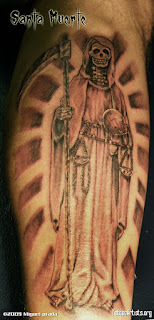Previous posts:
1. Death tattoos: Santa Muerte - origins and significations
2. Death tattoos: portrayals of the Santa Muerte
The two most common objects that Santa Muerte carries are a scythe and a globe.
The scythe can symbolize the cutting of negative energies or influences. Also, as a harvesting tool, it can symbolize hope and prosperity. It can represent the moment of death, when a scythe is said to cut a silver thread. The scythe has a long handle, indicating that it can reach anywhere.
The globe represents Death’s dominion and can be seen as a kind of a tomb to which we all return. Having the world in her hand also symbolizes vast power.
The crown - the symbol of royalty.
The presence of this symbol may be explained in two ways: firstly, the cult of Santa Muerte was highly influenced by the aztec cult of Mictecacihuatl, the queen of the Mictlan; secondly, Santa Muerte is ofted portrayed as a skeleton version of the Virgin of Guadalupe - Queen of Mexico and Empress of the Americas.
Flowers (especially roses)
Just like in real life, where Santa Muerte's shrines are adorned with flowers, the Santa Muerte tattoos are usually highly decorated with beautiful flowers. Another explanation for the presence of the flowers in these tattoos could be that the ephemeral flowers are reminder of the ephemerality of the (human) life.
The halo
The halo (also known as a nimbus, aureole, glory, or gloriole) - being a catholic saint, the presence of a nimbus is mandatory. Usually, the entire body of the Holy Death (Santa Muerte) is surrounded by a halo, but there are situations where the halo surrounds only the saint's head (a well-known visual convention in the representations of the saints in the Christian iconography).
Beautiful coloured hearts
The presence of the hearts in a death tattoo can seem strange to someone who is not familiar with the cult of Santa Muerte. The explanation is quite simple: Santa Muerte is not feared but loved. Santa Muerte's worshipers send her requests for love, affection, luck, money and protection, as well as malicious requests regarding their enemies.
The hourglasses
An hourglass indicates the time of life on earth. It also represents the belief that death is not the end, but rather the beginning of something new, as the hourglass can be turned to start over. The hourglass is also a symbol of the patience.
Human skulls, human bones, skeletons
The presence of the human bones (skulls or skeletons) in the depictions of the Santa Muerte is another proof of the link between the Santa Muerte worship and the ancient Aztec cult of Mictecacihuatl. Unlike the Christian beliefs about Death (Grim Reaper, Angel of Death, etc), according to which the role of the Death is to separate the human soul from the body and to guide the deceased to the next world, the Aztec deity Mictecacihuatl was the queen of the Mictlan; according to the Aztec religion she was living among her subjects and was keeping watch over the bones of the dead.
An owl
The owl symbolizes her ability to navigate the darkness and her wisdom. The owl is also said to act as a messenger.









No comments:
Post a Comment